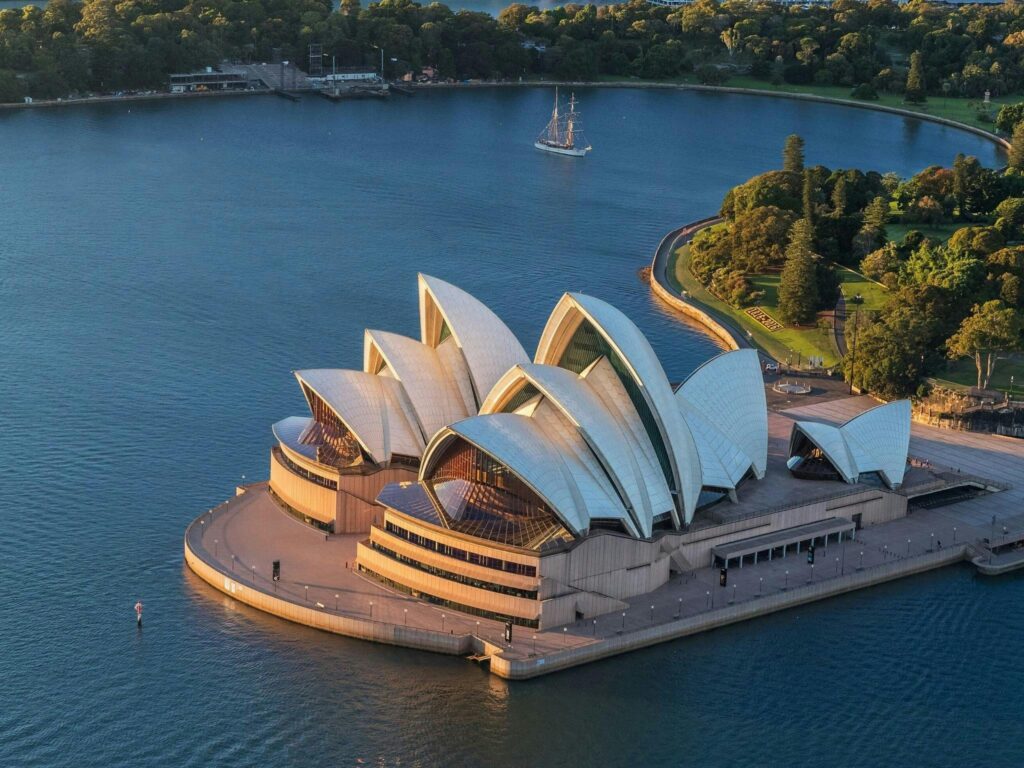
The Sydney Opera House is one of the most famous and distinctive architectural landmarks in the world. Located in the vibrant city of Sydney, Australia, it stands proudly on Bennelong Point, overlooking the stunning Sydney Harbour. Known for its innovative and unique design, the Opera House is not just a venue for world-class performances, but also a symbol of Australia’s creativity, culture, and architectural achievement. The structure’s iconic sail-like design and its significant role in the cultural life of the city make it a must-see for visitors and a source of national pride.
1. General Information
– Name: Sydney Opera House
– Location: Bennelong Point, Sydney Harbour, Australia
– Architect: Jørn Utzon
– Construction Start Date: 1957
– Completion Date: 1973
– Architectural Style: Expressionist Modernist
– Function: Multi-venue performing arts center
– Cultural Significance: A UNESCO World Heritage Site since 2007
– Height of Sails: 67 meters
2. History of the Sydney Opera House
The concept of an Opera House for Sydney was first proposed in the early 20th century, but it wasn’t until the 1950s that serious discussions began. In 1956, a design competition was held, attracting architects from around the world. The winning design came from Danish architect Jørn Utzon, whose visionary proposal featured a series of shell-like, white sails that appeared to be in motion, symbolizing the dynamic nature of performing arts.
The construction of the Opera House began in 1957, but the project encountered numerous challenges, including technical and financial issues. Despite these obstacles, the building was finally completed in 1973. The Opera House was officially opened by Queen Elizabeth II on October 20, 1973, marking a milestone in Australia’s cultural and architectural history.
3. Architectural Features of the Sydney Opera House
The Sydney Opera House is known for its distinctive sail-like roof design, which makes it one of the most recognizable buildings in the world. Some key architectural features include:
Sails and Roof Design: The roof consists of 14 white sail-like structures, which seem to rise and fall as if they are caught in a breeze, creating a fluid, organic shape. The design is an example of Expressionist architecture, emphasizing creativity and imagination.
- Building Materials: The Opera House is made of white-tiled concrete, giving it a bright, clean appearance. The sails were covered in over 1 million white ceramic tiles, specially designed to withstand the harsh coastal conditions.
- Interior Spaces: Inside, the Opera House contains multiple performance venues, including the Concert Hall, Drama Theatre, and Fore Court. The Concert Hall has a remarkable acoustical design, providing superior sound quality for symphonic performances, opera, and more.
Connection with the Harbour: The Opera House is set against the backdrop of Sydney Harbour and the Sydney Harbour Bridge, creating a stunning visual composition. The building is also easily accessible by water, with ferries docking close by.
4. Cultural and Touristic Significance
The Sydney Opera House is much more than a performing arts center; it has become an enduring symbol of Sydney and Australia’s cultural life. Here are some of the reasons why it is so significant:
Cultural Hub: The Opera House hosts thousands of performances each year, ranging from opera and ballet to theatre, concerts, and modern dance. It is a world-renowned venue where both local and international artists perform.
Tourism Magnet: As one of the most photographed buildings in the world, the Opera House attracts millions of tourists each year. It is an essential stop for anyone visiting Sydney, with tours offering insight into its architectural design and cultural history.
UNESCO World Heritage Site: In 2007, the Sydney Opera House was inscribed as a UNESCO World Heritage Site, recognized for its unique design and profound impact on architecture globally. It is regarded as one of the most important architectural landmarks of the 20th century.
National Icon: Beyond its architectural significance, the Opera House has become a national symbol of Australia’s artistic and cultural identity. Its image is synonymous with the country’s creativity and modernity.
5. Challenges and Controversies
Despite being celebrated worldwide, the Sydney Opera House faced many challenges throughout its construction. The project was plagued with delays, budget overruns, and technical difficulties. The final design was drastically different from the original concept, particularly in terms of the roof’s construction.
One of the most significant controversies arose when Jørn Utzon, the original architect, resigned from the project in 1966 due to mounting pressures and disagreements with the government. He did not live to see the completion of his masterpiece but his work has since been recognized and celebrated globally.
Conclusion
The Sydney Opera House is an architectural marvel and a cultural treasure that continues to inspire people around the world. Its sail-like design, symbolic of movement and creativity, has made it one of the most iconic buildings in the world. More than just a venue for the arts, it is a symbol of Australia’s commitment to innovation, culture, and global engagement.
Despite the challenges faced during its construction, the Sydney Opera House has become a defining feature of Sydney’s skyline and a lasting legacy of modernist architecture. It stands as a testament to the power of visionary design and the importance of preserving cultural landmarks for future generations.
The Sydney Opera House remains an enduring beacon of artistic expression, a hub for global culture, and a source of national pride for Australia. Its sails continue to rise above the Sydney Harbour, captivating visitors and performing artists alike.


No comments yet.